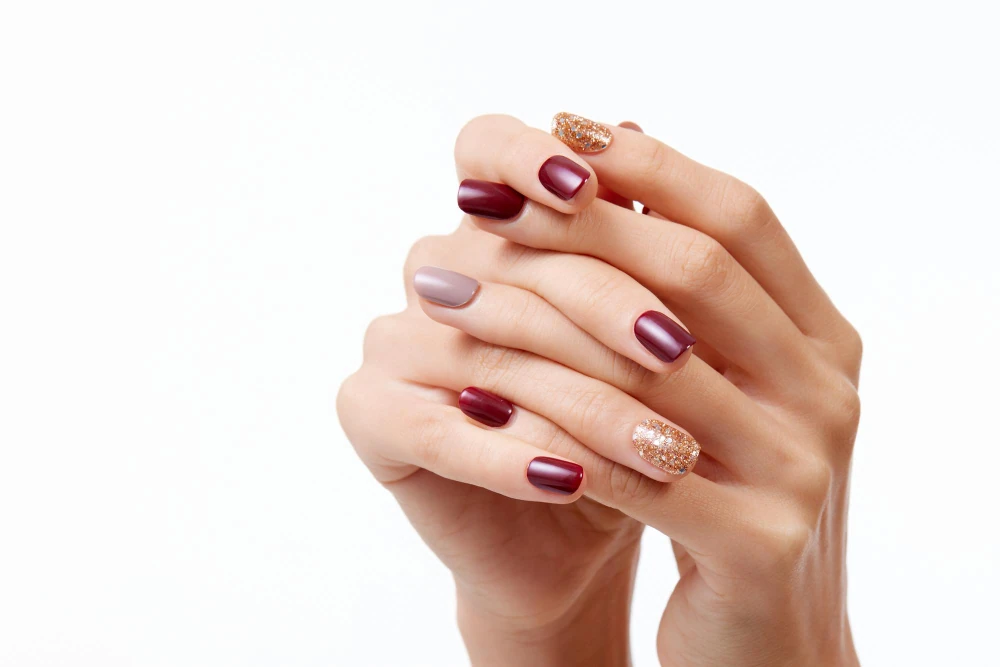Whether you’re prepping for a special occasion or simply want flawless nails every day, nail extensions can instantly elevate your look. But when it comes to choosing the right kind, the debate often boils down to Acrylic vs Gel Nails. Both are popular, durable, and stylish—but which one truly suits your lifestyle and preferences?
In this detailed guide, we’ll break down everything you need to know about Acrylic vs Gel Nails, from how they’re applied to how they wear over time. By the end, you’ll feel confident choosing the perfect nail extension method for your needs.
What Are Nail Extensions?
Nail extensions are enhancements placed over your natural nails to add length, strength, and style. They can be shaped, filed, and painted in endless ways to match your mood or occasion.
Two of the most commonly used methods are:
- Acrylic Nails
- Gel Nails
Let’s explore the differences, pros, cons, and suitability of Acrylic and Gel Nails in-depth.
What Are Acrylic Nails?

Acrylic nails are made by combining a liquid monomer with a powder polymer. When mixed, this forms a thick paste that is applied to your natural nail and shaped into the desired style. It hardens on its own without the need for a UV or LED lamp.
Key Features of Acrylic Nails:
- Hard and strong finish: Once dried, acrylics form a tough and rigid surface that offers strong protection for your natural nails.
- Long-lasting (up to 3–4 weeks): They can last several weeks with proper care, requiring infills only as your natural nails grow.
- Ideal for those who use their hands a lot: Whether you’re working on a keyboard all day or doing housework, acrylics can handle heavy use.
- Affordable and widely available: Most salons offer acrylics at a lower price point, and they’re commonly available almost everywhere.
Pros of Acrylic Nails:
- Durable and sturdy: Perfect for people who need their manicure to hold up through a busy or active routine.
- Easier to repair if broken: A broken acrylic can usually be fixed with a quick refill or patch, rather than needing to start over.
- Cost-effective in most salons: Acrylics are typically cheaper than gels, making them a good choice for regular wear.
- Suitable for long or dramatic nail shapes: You can go bold with shapes like stiletto, coffin, or almond thanks to acrylics’ solid structure.
Cons of Acrylic Nails:
- Can appear thick or less natural: Depending on the application, acrylics might not always look as sleek or natural as gel nails.
- Strong chemical odor during application: The monomer used in acrylics has a strong smell, which some people may find unpleasant.
- May weaken natural nails over time: Repeated use and removal can thin out the natural nail if not done carefully or with breaks.
- Requires filing, which can damage nail beds: Buffing and filing are necessary for application and removal, which may affect nail health over time.
What Are Gel Nails?

Gel nails are created using a gel-based formula that is cured (hardened) under a UV or LED lamp. This type of nail extension is more flexible and lightweight compared to acrylics.
Key Features of Gel Nails:
- Glossy, natural-looking finish: Gel nails have a shiny, smooth surface that mimics the natural nail’s appearance very closely.
- Flexible yet durable: They bend slightly with your natural nail, making them less likely to crack compared to rigid acrylics.
- Odor-free application: The gel formula doesn’t emit strong smells, which makes the process more comfortable for those sensitive to odors.
- Cured with UV/LED light: Gel nails require exposure to a UV or LED lamp to harden and set properly, making the process different from acrylics.
Pros of Gel Nails:
- Natural look and feel: Gel nails are known for their sleek and subtle finish that blends well with your natural nail.
- Less damaging to natural nails (if removed properly): When taken off correctly, gels are gentler on your nails compared to acrylics.
- No strong fumes during application: Unlike acrylics, gel nails don’t produce a chemical smell during the manicure.
- More comfortable due to flexibility: The slight bend in gel nails allows for a more natural movement, enhancing comfort.
Cons of Gel Nails:
- Can be expensive: Gel nail treatments usually cost more than acrylics due to materials and curing equipment.
- Difficult to fix if broken: Repairing a cracked gel nail can be tricky and often requires a full redo.
- Requires special tools for removal: Gel nails must be removed using acetone soak and proper techniques, unlike acrylics that can be filed off more easily.
- May not be as long-lasting as acrylics (lasts about 2–3 weeks): While durable, gels typically have a shorter lifespan than acrylic nails and might need more frequent maintenance.
Acrylic vs Gel Nails: Application Process
Understanding how each is applied can help you decide which suits your comfort level.
Acrylic Nail Application
- Nail prep and buffing: Natural nails are cleaned and lightly buffed to remove shine and create a rough base for better product adhesion.
- Length added with tips: Plastic tips are glued onto the edge of your natural nails to extend their length before applying the acrylic.
- Acrylic applied and shaped: A mixture of liquid monomer and powder polymer is applied over the nail and tips, then shaped using a brush to the desired form.
- Air-dried and refined: The acrylic hardens on its own within minutes. Once dry, the nails are buffed again for smoothness and refined shaping.
- Color or art added: Nail polish or nail art is applied on top of the finished acrylic base to complete the look.
- Time required: Typically takes around 45 minutes to 1 hour, depending on design complexity.
Gel Nail Application
- Nails are prepped like acrylics: Just like with acrylics, natural nails are cleaned, filed, and buffed to get them ready for gel application.
- Gel applied in layers: A thin layer of gel is brushed onto the nail surface—usually in 2 to 3 coats to build structure and color.
- Cured under UV/LED lamp: After each layer, the nails are placed under a UV or LED lamp for a few seconds to harden the gel.
- Top coat sealed and cured: A glossy top coat is applied and cured one final time to lock everything in and give a long-lasting shine.
- Time required: Usually takes about 45 minutes, slightly faster than acrylics depending on the number of layers.
Both methods take about the same time, but Acrylic vs Gel Nails vary in their technique and the sensation you might feel during the process.
Acrylic vs Gel Nails: Which Lasts Longer?
Durability is a major factor when deciding between Acrylic vs Gel Nails, especially if you’re looking for a long-lasting manicure with minimal touch-ups
- Acrylic nails are harder and tend to last longer (up to 4 weeks).
- Gel nails are more flexible but may chip or peel sooner (around 2-3 weeks).
However, with proper care, both can give you long-lasting results. Frequent handwashing, harsh chemicals, and nail biting can shorten the life of any extension.
Which Looks More Natural?
If your goal is a subtle, natural-looking enhancement, Gel nails often win.
- Acrylic nails tend to look thicker and more artificial, especially with longer or bold shapes.
- Gel nails are thinner and give a glossy, smooth finish that looks more like natural nails.
For everyday office wear or elegant minimalism, gel is often preferred. But for dramatic designs or bold fashion statements, acrylics offer more room for creativity.
Acrylic vs Gel Nails: Which Is Safer?
Safety depends on both application and removal.
Acrylic Nails:
- Contains strong chemicals that may cause allergic reactions in sensitive individuals.
- Over-filing during removal can lead to thinning of the nail bed.
Gel Nails:
- UV exposure during curing can be a concern (though modern lamps minimize risks).
- Improper removal (like peeling them off) can damage your natural nail.
To stay safe with either method, always visit a reputable salon and avoid DIY removals.
Which Is Easier to Remove?
Removing nail extensions the wrong way can seriously damage your nails. So let’s see how Acrylic vs Gel Nails compare in this area.
Removing Acrylic Nails:
- Soaked in acetone for 15–20 minutes
- Scraped off and filed
- Easier to remove at home (but still best done by a pro)
Removing Gel Nails:
- Buffed, then soaked in acetone with foil wraps
- Requires patience and care
- Often more stubborn to remove fully
Whichever you choose, avoid peeling or pulling—this can take off layers of your natural nail.
Who Should Choose Acrylic Nails?
- Acrylic nails are perfect if you want strong nails that last for weeks without breaking.
- They work well for people who use their hands a lot, like doing manual work or typing.
- If you like bold and long nail shapes, acrylics give the support you need for styles like stilettos or coffin nails.
- Acrylics are usually more affordable, so they’re great if you want a stylish look on a budget.
Who Should Choose Gel Nails?
- Gel nails are a great choice if you prefer a natural, smooth, and shiny look.
- They’re ideal for people who are sensitive to strong chemical smells during nail application.
- If you want nails that feel lightweight and comfortable, gels are perfect.
- Gel nails work best if you don’t need very long or dramatic nail extensions.
Acrylic vs Gel Nails: Final Verdict

So, acrylic or gel nails — which one should you go for?
It all comes down to your lifestyle and aesthetic preferences.
| Criteria | Best Option |
| Durability | Acrylic Nails |
| Natural Look | Gel Nails |
| Flexibility | Gel Nails |
| Bold Designs | Acrylic Nails |
| Sensitive Skin | Gel Nails |
| Budget-Friendly | Acrylic Nails |
Both methods have their place in the beauty world, and there’s no right or wrong choice—only what works best for you.
Tips for Long-Lasting Nail Extensions
No matter which side of the Acrylic vs Gel Nails debate you’re on, here are some tips to make your nails last longer:
- Avoid using your nails as tools, like opening cans or scratching surfaces.
- Keep your hands and cuticles moisturized regularly to prevent dryness and peeling.
- Don’t skip your infill appointments—getting them filled every 2 to 3 weeks helps maintain strength.
- Wear gloves when cleaning or washing dishes to protect your nails from harsh chemicals and water damage.
Conclusion
The Acrylic vs Gel Nails discussion doesn’t have a one-size-fits-all answer. Both offer stunning results in their own ways. Whether you want the strong hold of acrylics or the glossy finesse of gels, what matters most is how they fit your lifestyle, comfort, and budget.
Ready to try out either style? Make sure to consult with a professional nail artist who understands your needs and helps you choose the best method for you.
Frequently Asked Questions
1. How long do acrylic and gel nails typically last?
Acrylic nails usually last about 3 to 4 weeks before needing a refill, while gel nails typically last around 2 to 3 weeks. Proper care can extend their durability.
2. Which is better for natural nail health: acrylic or gel?
Gel nails tend to be less damaging to natural nails when applied and removed properly, as they are more flexible. Acrylics are stronger but can weaken natural nails if over-filed or removed incorrectly.
3. Can I paint or decorate acrylic and gel nails the same way?
Yes! Both acrylic and gel nails can be painted with regular nail polish or gel polish, and both support nail art, rhinestones, and other decorations.
4. Is the removal process painful for acrylic or gel nails?
Removal should not be painful if done correctly. Both acrylic and gel nails require soaking in acetone and gentle filing by a professional to avoid damage or discomfort.
5. Do acrylic or gel nails smell during application?
Acrylic nails have a noticeable chemical odor during application due to the liquid monomer, whereas gel nails have little to no smell.
6. Which nail extension method is more affordable?
Generally, acrylic nails are more affordable than gel nails, both for initial application and refills, but prices can vary depending on the salon and location.









